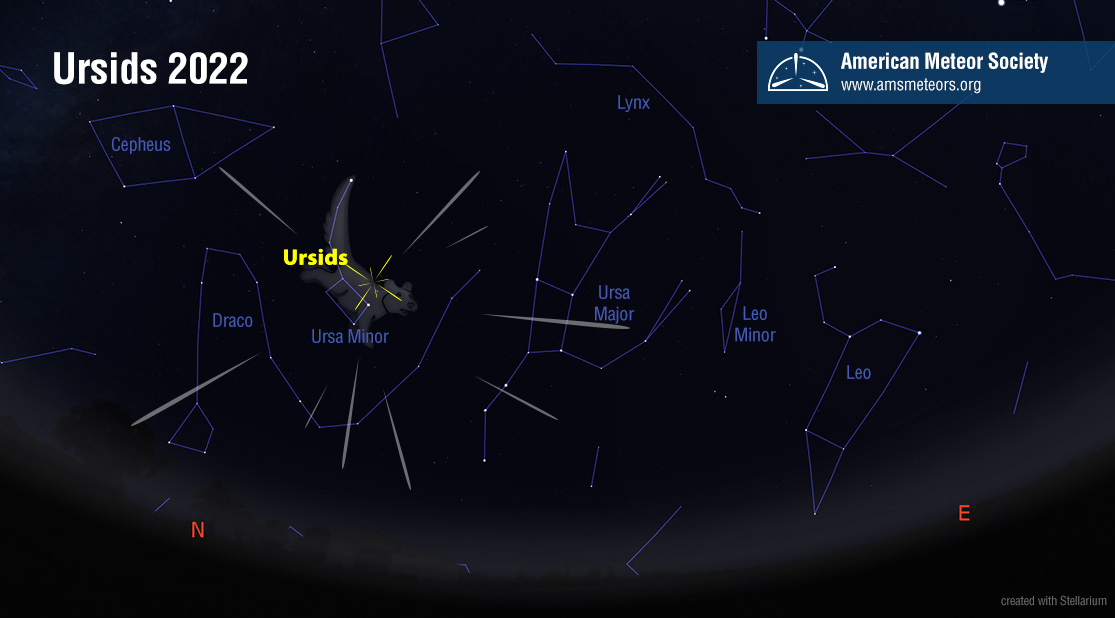
The Ursid meteor shower is the least observed of the major annual showers. In the northern hemisphere December nights are cold and often cloudy. Another hindrance is the fact that it peaks just before the Christmas holiday when many people are busy with holiday festivities. This shower is completely invisible from the southern hemisphere as the radiant lies too far north to be seen from south of the equator this time of year.
The Ursids are active from December 13-24 with a sharp maximum on December 22nd. Activity is normally low away from maximum with rates less than 1 shower member per hour. At maximum activity this source normally adds 5-10 medium velocity meteors to the 15 or so that are normally seen each morning hour from dark sky sites. This year though, the earth passes close to several past trails of debris that closely follow the orbit of comet 8P/Tuttle. This could enhance the Ursid activity seen this year. See the list of encounters in chronological order below listing the year of the debris trail, the expected time of maximum activity and the expected activity:
- filament encounter, December 22, 10h 21m UT Expected activity: ZHR=28
- 843 debris trail, December 22, 14h22m UT Expected activity: ?*
*Reference: 2022 Meteor Shower Calendar By Juergen Rendtel, page 20. https://www.imo.net/files/meteor-shower/cal2022.pdf
These predictions are no guarantee of enhanced activity as the timing is easier to predict than the density of the dust trails. The moon will be near its new phase and will not be visible at night on December 22nd. Both of these times favor North America, although the 843 event is only visible from Alaska and the western provinces of Canada. The northern polar and sub-polar regions of the Earth are also favored as the radiant remains high in the sky at all times.
At maximum, the Ursid radiant lies just west of the fairly bright (2nd magnitude) orange star known as Kochab (beta Ursae Minoris). To those not familiar with star names, this area lies adjacent to the bowl of the “Little Dipper” as shown in the illustration. This area of the sky lies lowest in the northern sky near 20:00 (8pm) local standard time. This is the worst time to view the Ursids as most of the activity will occur beyond your line of sight, below the northern horizon. As the night progresses the Ursid radiant will slowly rise higher into the northern sky and is best placed during the last dark hour before dawn. To best view this activity it is suggested that you face toward the northern half of the sky. It doesn’t have to be directly at the radiant, but it’s a good idea to have the radiant within your field of view to help with shower association. Don’t look straight up as this is the worst place to look for meteors. Lower you view so that none of the horizon blocks your view. About half way up in the sky is suggested for most observers.
Despite the bitter cold, try to view for at least an hour. Meteor activity is notoriously variable and if you view for only a short time, it may occur during a lull in activity. Viewing for at least an hour ensures you will see several peaks and valleys of activity. An estimate of your limiting magnitude is important in your report as it provides the sky condition during your watch. This is easily done by counting the number of stars visible with certain areas of the sky. Charts for these areas are available at: https://www.imo.net/observations/methods/visual-observation/major/observation/#table1. Areas 1, 7, and 19 on chart #3 would be the easiest to use. Using more than one area is also encouraged to provide more estimates. The conversion table is available in Table 2 on the link provided above. At least two estimates of the limiting magnitude are requested, hopefully at the beginning and end of your session. If conditions change during your session, more estimates will provide a more accurate figure for your data. Helpful tips for visual observing are also available at: https://www.imo.net/observations/methods/visual-observation/ and https://www.imo.net/observations/methods/visual-observation/major/observation/. In order to submit your observations we suggest that you fill out an online visual form provided by the International Meteor Organization. You must register to provide your data, but there is a free option for those not wishing to subscribe to the IMO Journal. Note that not every meteor will be an Ursid. There are several minor showers also active during this period adding a few meteors to the hourly total. There are also upwards of 10 random meteors appearing each hour to add to your count. Therefore shower association of each meteor must be included.
If you have never viewed this shower, be sure to check it out this year as a waxing gibbous moon will interfere with viewing this shower in 2023!
 American Meteor Society
American Meteor Society
Fireball sighting in Chugiak approximately 5:50 am December 21, 2022 directly from anchorage to Wasilla Ak